News
NASA Teleconference to Announce GLAST New Name, First Light Findings
08.26.08
The telecon will also include the Large Area Telescope's (LAT) first light results and a presentation of all the gamma-ray bursts that the GLAST Burst Monitor has seen since it went into operation.
Briefing participants:
> Jon Morse, Astrophysics Division Director, NASA Headquarters, Washington
> Dennis Kovar, Associate Director of Science for High Energy Physics, U.S. Dept. of Energy, Germantown, Md.
> Steve Ritz, GLAST Project Scientist, NASA's Goddard Space Flight Center, Greenbelt, Md.
> Peter Michelson, LAT Principal Investigator, Stanford University, Palo Alto, Calif.
> Charles "Chip" Meegan, GLAST Burst Monitor Principal Investigator, Marshall Space Flight Center, Huntsville, Ala.
Additional LAT team members participating to answer questions:
William Atwood, Santa Cruz Institute of Particle Physics, University of California at Santa Cruz
Ronaldo Bellazzini, INFN - Pisa
Patrizia Caraveo, INAF - Milan
Persis Drell, Director, Stanford Linear Accelerator Center, Stanford University
Isabelle Grenier, CEA/Saclay
Takashi Ohsugi, Hiroshima University
David Smith, CNRS/IN2P3 - Bordeaux
NASA's GLAST mission is an astrophysics and particle physics partnership, developed in collaboration with the U.S. Department of Energy, along with important contributions from academic institutions and partners in France, Germany, Italy, Japan, Sweden and the United States.
Presenter Materials
Jon Morse, Astrophysics Division Director, NASA Headquarters, Washington, D.C.

Dennis Kovar, Associate Director of Science for High Energy Physics, U.S. Dept. of Energy, Germantown, Md.
 Courtesy: Dr. Dennis Kovar
[No images]
Courtesy: Dr. Dennis Kovar
[No images]Steve Ritz, GLAST Project Scientist, NASA's Goddard Space Flight Center, Greenbelt, Md.
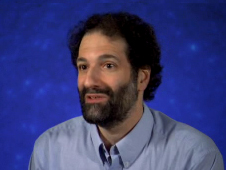 Credit: NASA
Credit: NASA> View video clip
> Transcript > Download presentation slides (pdf)
Peter Michelson, LAT Principal Investigator, Stanford University, Palo Alto, Calif.
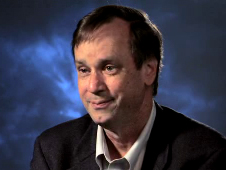 Credit: NASA
Credit: NASA> View video clip
> Transcript > Download presentation slides (pdf)
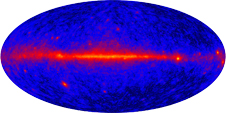
Image above: This all-sky view from GLAST reveals bright emission in the plane of the Milky Way (center), bright pulsars and super-massive black holes. Credit: NASA/DOE/International LAT Team
> Larger annotated version
> Larger unlabeled version
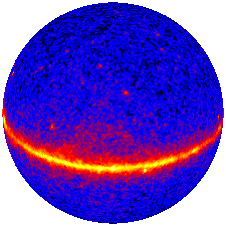
Image above: Astronomers wrapped the Fermi Gamma-ray Space Telescope's first all-sky map over a sphere to produce this view of the gamma-ray universe. Credit: NASA/DOE/International LAT Team
> Download video
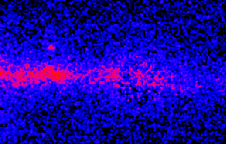
Image above: This close-up shows the Vela pulsar, which beams radiation every 89 milliseconds as it spins. The pulses are shown slowed by 20 times. Credit: NASA/DOE/International LAT Team
> Download video
Charles "Chip" Meegan, GLAST Burst Monitor Principal Investigator, Marshall Space Flight Center, Huntsville, Ala.
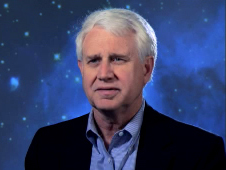 Credit: NASA
Credit: NASA> View video clip
> Transcript > Download presentation slides (pdf)
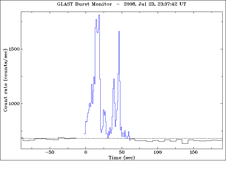
Image above: The GLAST Burst Monitor detected this gamma-ray burst on July 23, 2008. A typical burst associated with a star’s destruction, the event shows multiple brightness peaks. Credit: NASA/MSFC/GBM Team
> Larger image
Additional Broadcast Quality Video
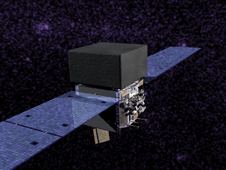
Image above: GLAST carries two instruments: the Large Area Telescope (LAT) and the GLAST Burst Monitor (GBM). This beauty shot provides a 360-degree view of the spacecraft with a simulated gamma-ray sky. Credit: NASA
> Download HD video
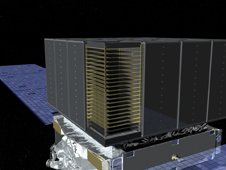
Image above: The Large Area Telescope (LAT) detects gamma rays in a technique known as pair production. This animation shows a gamma ray (purple) entering a corner tower of the Tracker. After the electron (red) and positron (blue) cascade down the tower, their incoming paths (red/blue) combine to show the original path (purple) of the incoming gamma ray that created them. This animation shows a gamma ray (purple) entering a corner tower of the Tracker. After the electron (red) and positron (blue) cascade down the tower, their incoming paths (red/blue) combine to show the original path (purple) of the incoming gamma ray that created them. Credit: NASA
> Download HD video
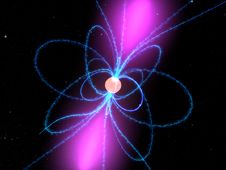
Image above: This animation takes us into a spinning pulsar, with its strong magnetic field rotating along with it. Clouds of charged particles move along the field lines and their gamma-rays are beamed like a lighthouse beacon by the magnetic fields. As our line of sight moves into the beam, we see the pulsations once every rotation of the neutron star. Credit: NASA
> Download HD video
Related links:
> Fermi: GLAST's New Name
> Enrico Fermi bio from Nobelprize.org
> GLAST feature -- Art and Science in Harmony: A Song for a Space Telescope
> Read the press release in Italian from Agenzia Spaziale Italiana
> Read the press release in German from the Max Planck Institute for Extraterrestrial Physics (pdf)